

Outbreak of Oropouche Virus in French Guiana - Volume 27, Number 10—October 2021 - Emerging Infectious Diseases journal - CDC. Mélanie Gaillet, Clara Pichard, Johana Restrepo, Anne Lavergne, Lucas Perez, Antoine Enfissi, Philippe Abboud, Yann Lambert, Laurence Ma, Marc Monot, Magalie Demar, Felix Djossou, Véronique Servas, Mathieu Nacher, Audrey Andrieu, Julie Prudhomme, Céline Michaud, Cyril Rousseau, Isabelle Jeanne, Jean-Bernard Duchemin, Loïc Epelboin1 , and Dominique Rousset1 Author affiliations: Cayenne Hospital Center, Cayenne, French Guiana (M.
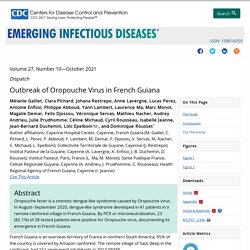
Non-Invasive versus Invasive Samples for Zika Virus Surveillance: A Comparative Study in New Caledonia and French Guiana in 2015–2016. All articles published by MDPI are made immediately available worldwide under an open access license.
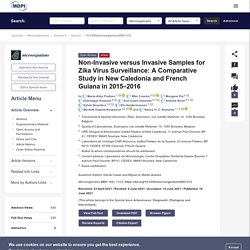
No special permission is required to reuse all or part of the article published by MDPI, including figures and tables. For articles published under an open access Creative Common CC BY license, any part of the article may be reused without permission provided that the original article is clearly cited. Feature Papers represent the most advanced research with significant potential for high impact in the field. Feature Papers are submitted upon individual invitation or recommendation by the scientific editors and undergo peer review prior to publication. Première épidémie à virus Oropouche dans un territoire ultra marin français. Spatial variations in Leishmaniasis: A biogeographic approach to mapping the distribution of Leishmania species. Abstract Cutaneous Leishmaniasis (CL) is the most prevalent form of Leishmaniasis and is widely endemic in the Americas.
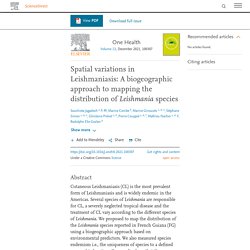
Several species of Leishmania are responsible for CL, a severely neglected tropical disease and the treatment of CL vary according to the different species of Leishmania. We proposed to map the distribution of the Leishmania species reported in French Guiana (FG) using a biogeographic approach based on environmental predictors. We also measured species endemism i.e., the uniqueness of species to a defined geographic location. Our results show that the distribution patterns varied between Leishmania spp. and were spatially dependent on climatic covariates. Allergy to Mammalian Meat Linked to Alpha-Gal Syndrome Potentially After Tick Bite in the Amazon: A Case Series in: The American Journal of Tropical Medicine and Hygiene - Ahead of print. Outbreak of Oropouche Virus in French Guiana - Volume 27, Number 10—October 2021 - Emerging Infectious Diseases journal - CDC.
Immunoblot for the Diagnosis of Cutaneous Leishmaniasis in French Guiana. - Abstract. Cutaneous leishmaniasis (CL) is firmly established in South America.
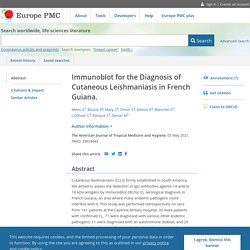
We aimed to assess the detection of IgG antibodies against 14 and/or 16 kDa antigens by immunoblot (IB) for CL serological diagnosis in French Guiana, an area where many endemic pathogens could interfere with it. This study was performed retrospectively on sera from 141 patients at the Cayenne tertiary hospital: 30 were patients with confirmed CL, 71 were diagnosed with various other endemic pathogens, 11 were diagnosed with an autoimmune disease, and 29 controls had no history of CL. Antibodies bound to the 14 and/or 16 kDa antigens in 27 of the 30 CL patients' sera and in 39 of the 111 non-CL patients' sera (26 from the infectious diseases group, four from the autoimmune diseases group, and nine from the dermatology department). The method tested showed a high sensitivity (90%) and a low specificity (66%), and a diagnosis odds ratio of 17.5 (95% CI [4.6-78.0]). Field Performance of Mass PCR Screening and Targeted Treatment in an Amazonian Low Malaria Transmission Setting.
Contribution of Research in the West Indies and Northeast Amazonia to Knowledge of the 2014–2015 Chikungunya Epidemic in the Americas. 1.Thiberville S-D, Boisson V, Gaudart J, Simon F, Flahault A, de Lamballerie X.
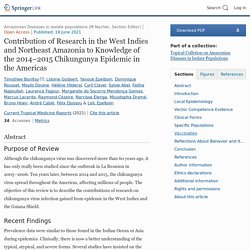
Chikungunya fever: a clinical and virological investigation of outpatients on Reunion Island, South-West Indian Ocean. Tesh RB, éditeur. Spatial Distribution and Burden of Emerging Arboviruses in French Guiana. MDPI and ACS Style Bailly, S.; Rousset, D.; Fritzell, C.; Hozé, N.; Ben Achour, S.; Berthelot, L.; Enfissi, A.; Vanhomwegen, J.; Salje, H.; Fernandes-Pellerin, S.; Saout, M.; Lavergne, A.; Manuguerra, J.
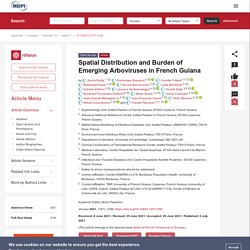
-C.; Carod, J. -F.; Djossou, F.; Cauchemez, S.; Flamand, C. Spatial Distribution and Burden of Emerging Arboviruses in French Guiana. Viruses 2021, 13, 1299. When local phytotherapies meet biomedicine. Cross-sectional study of knowledge and intercultural practices against malaria in Eastern French Guiana. Abstract Ethnopharmacological relevance In French Guiana, traditional phytotherapies are an important part of self-healthcare, however, a precise understanding of the interactions between local phytotherapies and biomedicine is lacking.

Malaria is still endemic in the transition area between French Guiana and Brazil, and practices of self-treatment, although difficult to detect, have possible consequences on the outcome of public health policies. Aim of the study. Setting-up a cross-border action-research project to control malaria in remote areas of the Amazon: describing the birth and milestones of a complex international project (Malakit) Intervention development steps The intervention was designed after the initial idea was validated by the partners from the three countries involved i.e. the distribution at border resting sites of a self-diagnostic and self-treatment kit to gold miners, to be used when needed, within the context of their activity on the French Guianese territory [3].
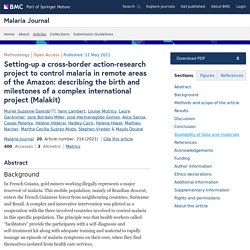
The design of the intervention itself overlaps with that of its evaluation (Fig. 3). Phases of the Malakit project over time. Maliqua: A study within Malakit, a project on malaria and gold miners in French Guiana. Self-Diagnosis and Self-Treatment of Malaria in Hard-to-Reach and Mobile Populations of the Amazon: Results of Malakit, a Multicentric Intervention Research Project. Towards a Paradigm Shift? by Maylis Douine, Yann Lambert, Muriel Galindo, Louise Mutricy, See all articles by Maylis Douine Maylis Douine Cayenne Hospital - Centre d’Investigation Clinique Antilles-Guyane; Universite de Guyane - TBIP Yann Lambert.
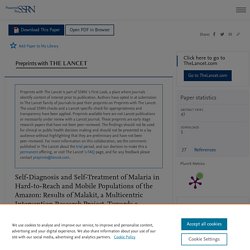
Accuracy of SD Malaria Ag P.f/Pan® As A Rapid Diagnosis Test of Malaria in French Amazonia - Abstract. Background: French Guiana (FG) is, with Mayotte island, one of the two French overseas territories where malaria is still endemic.
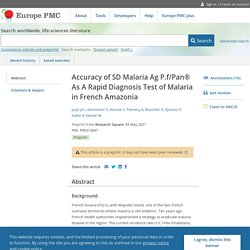
Ten years ago, French health authorities implemented a strategy to eradicate malaria disease in the region. The current incidence rate is 0,74‰ inhabitants, and Plasmodium Vivax is widely predominating even though Plasmodium Falciparum is still present due to imported cases, mainly from the Africa continent. In FG, RDT (SD Malaria Ag P.f/Pan®) test is based on detection of pan-pLDH, PfHRP2, and PfHRP3 antigens. Primaquine à visée « altruiste » et paludisme à Plasmodium falciparum en Guyane. In utero Zika virus exposure and neurodevelopment at 24 months in toddlers normocephalic at birth: a cohort study. All women whose pregnancy overlapped with the 2016 ZIKV epidemic in Guadeloupe, Martinique, or French Guiana who sought antenatal care at one of the participating hospitals were invited to participate in the ZIKA-DFA-FE prospective cohort study of pregnant women, for which the recruitment and ZIKV testing strategies have been previously described [3].
ZIKA-DFA-BB was a prospective cohort study of toddlers born to women whose pregnancies overlapped with the 2016 ZIKV epidemic in French territories in the Americas: Guadeloupe, Martinique, and French Guiana. Toddlers were followed up in routine pediatric consultation until 24 months of age. Inclusion in analysis Exposure assessment. Malaria in Gold Miners in the Guianas and the Amazon: Current Knowledge and Challenges. 1.World Health Organization. WHO | Global technical strategy for malaria 2016-2030. 2016 [cited 2018 Mar 28]. Available from: Health Organization World malaria report 2019. World Health Organization; 2019.3.Pan American Health Organization. Report on the situation of malaria in the Americas – 2017. 2017 [cited 2019 Aug 16].
Available from: Eer ED, Bretas G, Hiwat H. Spatio-Temporal Dynamics of Plasmodium falciparum and Plasmodium vivax in French Guiana: 2005–2019. 1. Introduction Understanding the dynamics of malaria transmission is crucial for the development and implementation of successful interventions that could reduce risk. Prolonged Maternal Zika Viremia as a Marker of Adverse Perinatal Outcomes - Volume 27, Number 2—February 2021 - Emerging Infectious Diseases journal - CDC.
The recent worldwide epidemic confirmed maternal–fetal transmission of Zika virus (ZIKV) and its association with adverse perinatal outcomes, particularly severe central nervous system lesions and fetal losses (1–3). Whether prolonged viremia after ZIKV infection in pregnant women represents a risk factor for maternal–fetal transmission, congenital Zika syndrome (CZS), or other adverse outcomes is on ongoing controversy (4). ZIKV is detectable in maternal blood by reverse transcription PCR (RT-PCR) during the acute phase of infection. ZIKV viremia usually lasts from 2 days before to 16 days after symptom onset; median time of ZIKV RNA clearance is 5 days (5). Driggers et al. (6) detected ZIKV RNA in maternal serum samples 8 weeks after onset of clinical symptoms; they suggested that prolonged viremia might occur as a consequence of viral replication in the fetus or placenta and might be correlated with CZS.
Study Population, Recruitment, and Follow-up. Et si on changeait de paradigme ? Autodiagnostic et autotraitement pour le paludisme des personnes isolées d’Amazonie : résultats d’un projet de recherche opérationnelle innovant. Kelch13 mutations in Plasmodium falciparum and risk of spreading in Amazon basin countries. Skip to Main Content Advertisement Search Close.